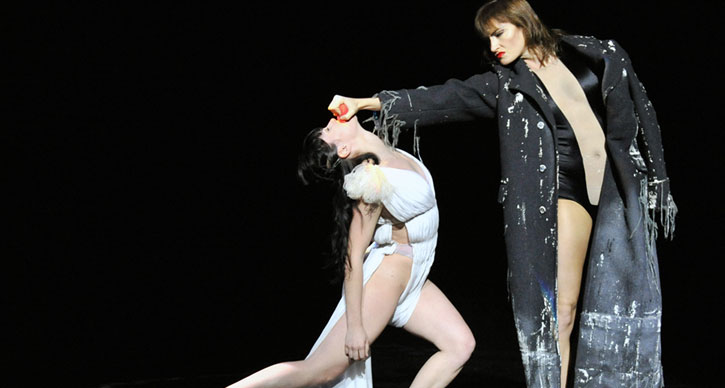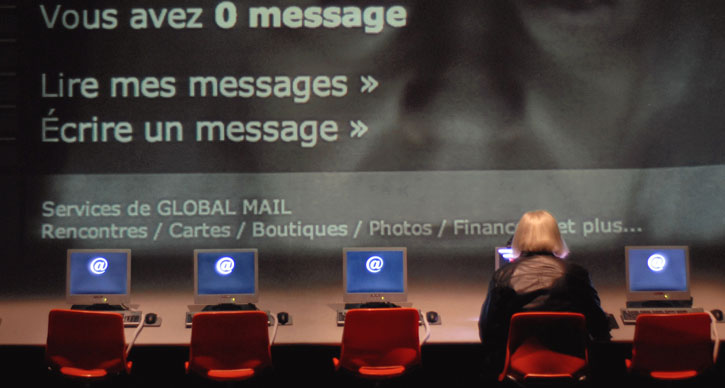Once Upon a Time, in a land called The Power Center…
Photo: A scene in Snow White by Ballet Preljocaj.
Every great story rests upon a conflict of good and evil. As children, we might encounter lessons from this kind of conflict through fairy tales, morals and legends. We hear frightening tales with themes of greed, lust, disobedience, and consequences that most often resolve with the poetic justice of a happily-ever- after ending. These age-old tales are an imaginative vehicle for children to relate to the dark side of human nature and to understand the power of choice and free will.
Fairy tales are not just for children however. There’s been an increase in fairy-tale prime time TV, ABC’s Once Upon a Time and NBC’s Grimm, for example, as well as a surge in live-action movies, Mirror, Mirror and Snow White and the Huntsman, to name a couple. As adults, we still love these stories and we still relate to their symbols and themes.
UMS is presenting two artists whose work is influenced by fairy tales: Robert Lepage’s The Andersen Project and Snow White re-staged by Ballet Preljocaj.
The Andersen Project is inspired by the life of Hans Christian Andersen and highlights the fairy tale “The Dryad,” which is set in nineteenth century Paris and follows a young dryad who lives within chestnut tree on the outskirts of the city. The dryad longs to see the Paris she hears about in the stories of those who travel past her. When her wish is granted, she is moved the heart of the city, but her happiness there is short-lived. As Her true desire is not for the city, but for the freedom of movement, it turns out. When this wish is granted, it comes with a heavy cost. Read the whole story.
The Andersen Project also references Andersen’s “The Shadow.” In “The Shadow,” a man loses his own shadow. One night, it returns, knocking on his door and appearing almost human. The shadow grows richer and fatter, while the man grows poorer and weaker. In fact, the man is so ill that his shadow proposes a trip to a health resort, on the condition that the shadow can act as the master. At the resort, the shadow meets a princess, and later when the two are about to be marry, the shadow offers the man a position within the castle if he agrees to become his own shadow permanently. In the end, the secret swap is revealed and the consequences are deadly. Read the whole story.
We interviewed The Andersen Project’s lead actor Yves Jacques. Start at 3:16 mark to learn about how old ways of storytelling influenced director Robert Lepage’s construction of this project.
Snow White may be a more familiar story for most. Choreographer Angelin Preljocaj explains that his narrative ballet is not the myth or legend of Snow White, but the story of Snow White herself. He follows the Grimm brothers’ version version but adds small variations. The wicked stepmother is the central character of the tale. He examines her through her narcissistic determination not to give up on seduction and on her role as a woman, even if this means sacrificing her stepdaughter. Do you need a Snow White refresher? Read the whole story.
We are living during a climatic time in history and our choices can be felt globally thanks to technology. Is it any wonder that artists are turning to the world of fairy tales to highlight the fight between good and evil or the power of choice? Fairy tales allow us to reach into our imagination and to examine the good and evil that reside in all of us.
Why do you think fairy tales are on the rise? What are your favorite fairy tales?
5 Things to Know About The Andersen Project
1. Lepage initially created the role that is now performed by Yves Jacques, his “go-to” person for his one-man shows (Jacques was also the actor in Far Side of the Moon in 2005). The play is multi-layered and, like 08/09 Season’s Complicite, enjoyable on many levels – either at the top-level story or digging deeper into the meaning at its core.
2. Jacques plays all three main characters: Frederic, an albino rock lyricist from Montreal who heads to Paris to write the libretto for a children’s opera based on a Hans Christian Andersen story; Arnaud, the opera company’s fast-talking administrator whose personal life is unraveling due to his sexual obsessions; and Rashid, a Moroccan janitor who mops up after clients at a peep show that is located on the first floor of the same building that houses the apartment Frederic is subletting.
3. An example of the multi-layered structure: Lepage was commissioned to write a piece about Andersen to commemorate the 200th anniversary of his birth. His story is about a man who is commissioned to write a libretto for a children’s opera about Andersen. Two of Andersen’s fairy tales are woven into the script. The Dryad is about a tree nymph who sacrifices a long life in the woods for a single day in Paris – a parallel to the librettist, who is seeking artistic validation outside of his own country.
4. Those who have traveled in France will see many connections to what makes the French, well, French. There’s an opening monologue by the opera director, Arnaud, that is breathtaking in its scope and humor – nearly 2,000 words run together in a rambling yet coherent style that only the great storytellers like Spalding Gray or Garrison Keillor can accomplish. The monologue is performed with a strong accent, and every word is not intended to be understood — it’s meant to give a flavor of the character and his obsessive personality.
5. The piece is in both English and French (with supertitles). The constantly shifting projections and stagecraft make the technical aspects of the production at least as fascinating as the story itself.
Ultimately, The Andersen Project is really about an artist searching for validation and fame, unraveling relationships, and dealing with personal demons. The story itself is accessible in that The Andersen Project focuses on larger life issues that virtually everyone deals with at some point and can relate to in multiple ways.
See The Andersen Project March 15-17 at the Power Center.




